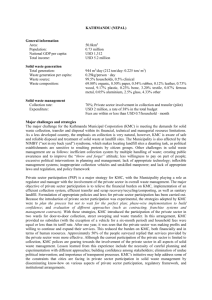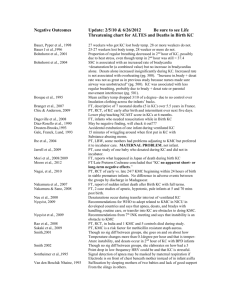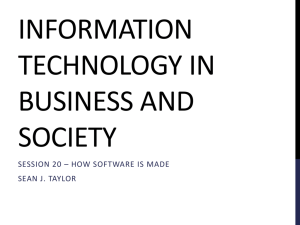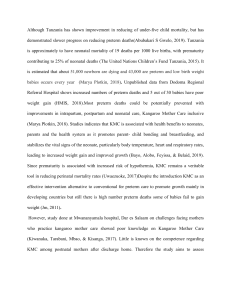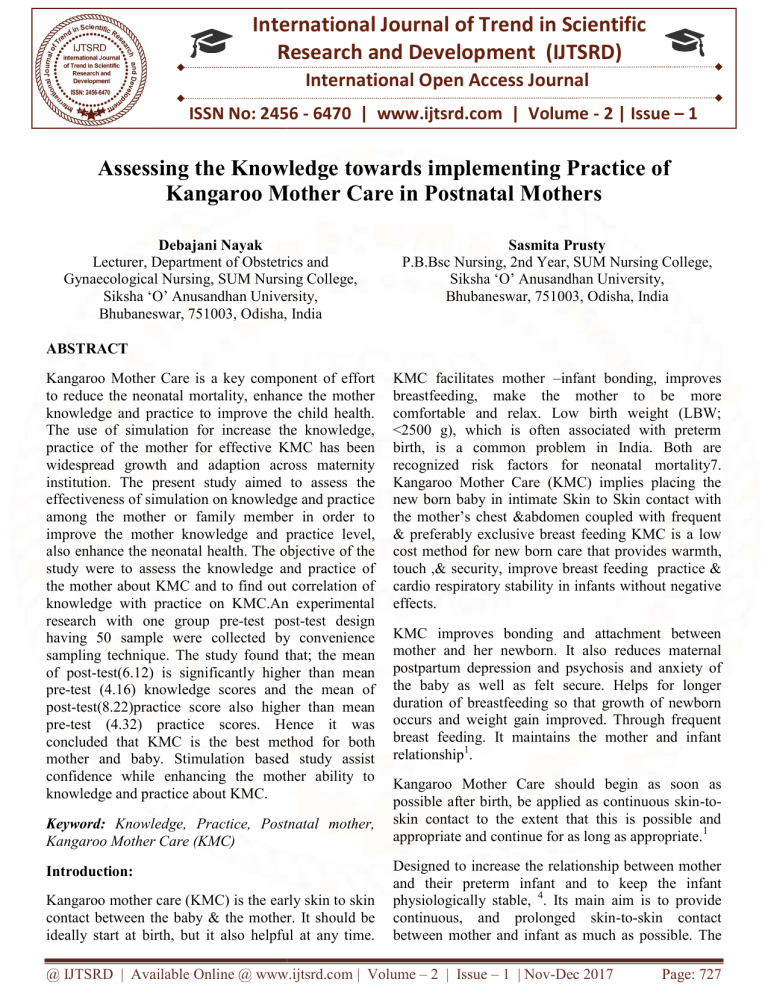
International Journal of Trend in Scientific
Research and Development (IJTSRD)
International Open Access Journal
ISSN No: 2456 - 6470 | www.ijtsrd.com | Volume - 2 | Issue – 1
Assessing the Knowledge
nowledge towards iimplementing
mplementing Practice
P
of
Kangaroo Mother Care in Postnatal M
Mothers
others
Debajani Nayak
Lecturer, Department of Obstetrics and
Gynaecological Nursing, SUM Nursing College,
Siksha ‘O’ Anusandhan University,
Bhubaneswar, 751003, Odisha, India
Sasmita Prusty
P.B.Bsc Nursing, 2nd Year, SUM Nursing College,
Siksha ‘O’ Anusandhan University,
Bhubaneswar, 751003, Odisha, India
ABSTRACT
Kangaroo Mother Care is a key component of effort
to reduce the neonatal mortality, enhance the mother
knowledge and practice to improve the child health.
The use of simulation for increase the knowledge,
practice of the mother for effective KMC has been
widespread growth and adaption across maternity
institution. The present study aimed to assess the
effectiveness of simulation on knowledge and practice
among the mother or family member in order to
improve the mother knowledge
ledge and practice level,
also enhance the neonatal health. The objective of the
study were to assess the knowledge and practice of
the mother about KMC and to find out correlation of
knowledge with practice on KMC.An experimental
research with one group pre-test post
post-test design
having 50 sample were collected by convenience
sampling technique. The study found that; the mean
of post-test(6.12)
test(6.12) is significantly higher than mean
pre-test
test (4.16) knowledge scores and the mean of
post-test(8.22)practice score also
lso higher than mean
pre-test
test (4.32) practice scores. Hence it was
concluded that KMC is the best method for both
mother and baby. Stimulation based study assist
confidence while enhancing the mother ability to
knowledge and practice about KMC.
Keyword: Knowledge,
owledge, Practice, Postnatal mother,
Kangaroo Mother Care (KMC)
Introduction:
Kangaroo mother care (KMC) is the early skin to skin
contact between the baby & the mother. It should be
ideally start at birth, but it also helpful at any time.
KMC facilitates mother –infant
infant bonding, improves
breastfeeding, make the mother to be more
comfortable and relax. Low birth weight (LBW;
<2500 g), which is often associated with preterm
birth, is a common problem in India. Both are
recognized risk factors for neonatal mortality7.
mor
Kangaroo Mother Care (KMC) implies placing the
new born baby in intimate Skin to Skin contact with
the mother’s chest &abdomen coupled with frequent
& preferably exclusive breast feeding KMC is a low
cost method for new born care that provides warmth,
war
touch ,& security, improve breast feeding practice &
cardio respiratory stability in infants without negative
effects.
KMC improves bonding and attachment between
mother and her newborn. It also reduces maternal
postpartum depression and psychosis and
a anxiety of
the baby as well as felt secure. Helps for longer
duration of breastfeeding so that growth of newborn
occurs and weight gain improved. Through frequent
breast feeding. It maintains the mother and infant
relationship1.
Kangaroo Mother Care should
ould begin as soon as
possible after birth, be applied as continuous skin-toskin
skin contact to the extent that this is possible and
appropriate and continue for as long as appropriate.1
Designed to increase the relationship between mother
and their preterm infant
nfant and to keep the infant
physiologically stable, 4. Its main aim is to provide
continuous, and prolonged skin-to-skin
skin
contact
between mother and infant as much as possible. The
@ IJTSRD | Available Online @ www.ijtsrd.com | Volume – 2 | Issue – 1 | Nov-Dec
Dec 2017
Page: 727
International Journal of Trend in Scientific Research and Development (IJTSRD) ISSN: 2456-6470
skin to skin care will improved the outcomes in terms
of breastfeeding, weight gain, body temperature,
respiration rate, heartrate of the infant, duration of
hospital stay, and infant–maternal bonding.3,2 KMC
practice had a great advantage for low birth weight
infants in India.
KMC improves growth in low birth weight infants
and has a significant role in protecting the LBW
infant from hypothermia, hypoglycaemia and sepsis.
It is definitely feasible, acceptable to mothers and can
be continued at home in the Indian set up.5The
purpose of this study was to determine the knowledge
and implement the practice of KMC upon postnatal
mothers and their infants.
Statement of the problems:
Assess the knowledge and practice of mother
regarding kangaroo mother care in a selected hospital
of Odisha.
Objective of the study:
1. To assess the knowledge of the mother about
KMC.
2. To impliment the practice of mother about KMC.
Methodology
Aquassi experimental research approach with Preexperimental one group pre-test post-test design was
adopted for this study. 50 postnatal mothers were
collected by convenience sampling technique. The
tools used for the study were knowledge questionnaire
and checklist to assess practice of the mother
regarding KMC. The tool was consisted of 3 section.
Section A consists demographic characteristics of
mother, SectionB consists of 10 question of checklist
regarding knowledge aspect and Section C consists of
10 multiple choice question of practice aspectThe
tools were validated by seven experts in the field of
the nursing. . The experts were requested to give their
suggestion and opinion regarding the relevance,
adequacy and appropriateness of the items in the tool.
The reliability and feasibility was established by
administering the tool to 10 postnatal mother. The
obtained data was analysed by using descriptive and
inferential statistics in terms of frequency, percentage,
and mean, median. ’t’ value and co relation test.
RESULT AND DISCUSSION
Distribution study samples according to the
SocioDemographic variables
As regards age of the sample, 48% of samples were in
less than 20 years of age, 28% in between 20-30 years
of age and 24% in greater than 30 years of age.
Religion of the sample women shows that 50% of
samples were Hindu, 28% of sample were Christian
and 22% of sample were Muslim.
In education status of the samples 48% of samples
had primary education, 30% of samples were illiterate
and 22% of samples had high school education.
The maximum 70% of samples are house wife and
30% of samples were working mother.
Almost half of the samples that 50% of samples were
stay in hospital from 3-7 days, 30% of samples were
stay in hospital more than 7 days and 20% of samples
were stay in hospital less than 3 days.
For parity of the mothers 42% of samples were
multipara, 36% of samples were primipara and 22%
of samples were grandmulti para.
Finding related
regarding KMC
to
evaluation
ofknowledge
Table -1: Mean,Median,SD,‘t’ Value and P Value of
pretest and posttest knowledge scores of sample
mothers regarding kangaroo mother care.
N=50
df
‘t’
Value
P
Value
Group
Mean Med SD
Pretest
4.16
4
0.841
Post
6.12
6
1.189 49 13.46*
0.14
* Significant at 0.05 level of significance
The descripted in table 1 show that the post-test
knowledge scores of mean(6.12),median (6),SD
(1.189) was higher than the pre-test mean
(4.16),median (4) and SD( 0.84 which was found to
be statistically significant as evident from 't' value of
13.46 for df49 at 0.05 level of significance.
Thisshows that the obtained mean difference between
the pretest and the posttest knowledge score was a
@ IJTSRD | Available Online @ www.ijtsrd.com | Volume – 2 | Issue – 1 | Nov-Dec 2017
Page: 728
International Journal of Trend in Scientific Research and Development (IJTSRD) ISSN: 2456-6470
true difference and not by chance. This indicates that
the knowledge score of the posttest was significantly
higher than the pretest. Which found that posttest
knowledge of sample mothers were increased than
pretest.
Table -2: Mean, Median, SD, ‘t’ Value and P Value
of pretest and posttest practice scores of sample
mothers regarding kangaroo mother care.
N=50
Group
Mean Med
SD
df
Pretest
4.32
4
0.998 49
Post
8.22
8
0.840
T
Value
P
Value
23.01* 0.17
* Significant at 0.05 level of significance
Data shows in table 10 found that:
The post-test practice score of mean(8.22),median
(8),SD (0.998) was higher than the pre-test mean
(4.32),median (4) and SD ( 0.840) which was found to
be statistically significant as evident from 't' value of
23.01 for df49 at 0.05 level of significance.
Thisshows that the obtained mean difference between
the pretest and the posttest practice score was a true
differenceand not by chance. This indicates that the
practice score of the posttest was significantly higher
than the pretest.
Ethical consideration: The research problem and
objectives where approved by the research committee.
Informed consent was obtained from the postnatal
mothers in IMS and SUM Hospital. Explanation was
given regarding the purpose of the study and
confidentiality was ensured. Due permission from
authorities has been sought and obtained
CONCLUSION
The conclusion was drawn after concluding the study.
The study show that there was significant gain in
knowledge and practice of KMC by postnatal mothers
after the procedure done.Which found that posttest
knowledge and practice of KMC of sample mothers
were increased than pretest. The finding conclude that
demonstration of KMC by the researcher was found to
be helpful in enhancing knowledge and also the
mothers implemented into practice with more
satisfaction
REFERENCES:
1. Nyqvist KH, Anderson GC, Bergman N, Cattaneo
A, Charpak N, Davanzo R, Ewald U, Ibe O,
Ludington‐Hoe S, Mendoza S, Pallás‐Allonso C.
Towards universal kangaroo mother care:
recommendations and report from the first
European conference and seventh international
workshop
on
kangaroo
mother
care.
ActaPaediatrica. 2010 Jun 1;99(6):820-6.
2. Tessier R, Cristo M, Velez S, Girón M, de Calume
ZF, Ruiz-Paláez JG, Charpak Y, Charpak N.
Kangaroo mother care and the bonding
hypothesis. Pediatrics. 1998 Aug 1;102(2):e17-.
3. Conde‐Agudelo A, Díaz‐Rossello JL. Kangaroo
mother care to reduce morbidity and mortality in
low birthweight infants. The Cochrane Library.
2016 Jan 1.
4. World Health Organization. Reproductive Health.
Kangaroo mother care: a practical guide. World
Health Organization; 2003 Apr 17.
5. Suman Rao PN, Udani R, Nanavati R. Kangaroo
mother care for low birth weight infants: a
randomized controlled trial. Indian pediatrics.
2008;45(1):17.
6. Charpak N, Figueroa Z. Kangaroo mother care
programme practical rules. Bogota, Columbia:
Kangaroo Foundation; 2001.
7. Brahmapurkar KP, Brahmapurkar VK, Zodpey
SP. Under-Five Mortality Rate Reduction-a
Challenge and Opportunity for Madhya Pradesh,
India. Community Med. 2016;7(5):442-8.
8. Dodd VL. Implications of kangaroo care for
growth and development in preterm infants. J
ObstetGynecol Neonatal Nurs 2005; 34: 218-232.
9. Singh M. Temperature regulation. In: Care of the
newborn. Singh M. 5th edition. New Delhi: Sagar
Publications; 2000. p. 190-197.
@ IJTSRD | Available Online @ www.ijtsrd.com | Volume – 2 | Issue – 1 | Nov-Dec 2017
Page: 729

